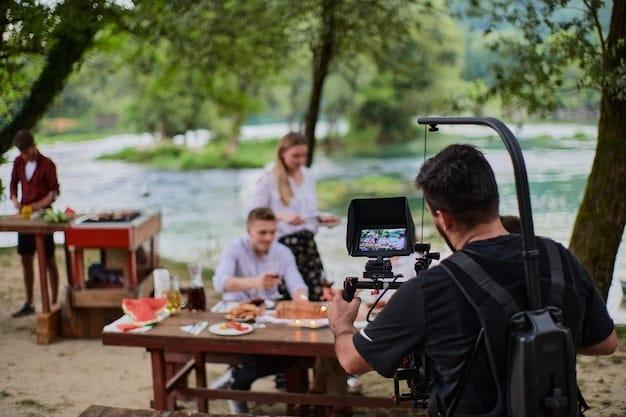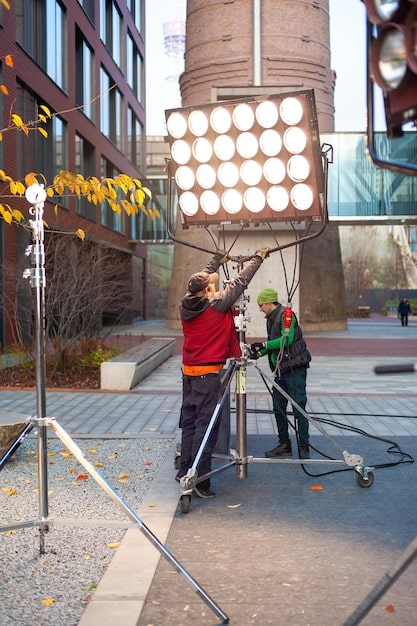Short Film Production Guide: Script to Screen Under $5,000 (US)

Creating a short film in the US for under $5,000 is achievable with careful planning. This guide covers everything from script development to post-production, offering a step-by-step approach for aspiring filmmakers on a budget.
Turning your cinematic dreams into reality doesn’t require a Hollywood budget. This guide, From Script to Screen: A Step-by-Step Guide to Producing Your First Short Film in the US, Budget Under $5,000, will help you navigate the process of creating a compelling short film without breaking the bank. We’ll explore each stage of production, offering practical tips and cost-effective strategies every step of the way.
Planning Your Short Film: Script and Storyboard
The foundation of any great film, short or feature-length, begins with a strong script. Solidifying your initial idea on paper is the first crucial step in the filmmaking process.
Developing a Compelling Script
A well-written script is essential for attracting talent and securing locations, not to mention telling a great story. Focus on concise storytelling and character development. Even under a tight budget, aim for quality writing.
Creating a Detailed Storyboard
Visualizing your script through a storyboard can save time and money during filming. A storyboard helps you plan shots, camera angles, and overall composition beforehand, ensuring a smoother production process.
- Benefit of pre-visualization.
- Better time management in production.
- Cost-effective decision making and planning.
Planning is a time for creativity. The more time that you can dedicate to this stage, the better your chance of making the best film for your budget.

Budgeting and Funding Your Short Film
Managing your finances effectively is critical for staying within your $5,000 budget. Proper allocation and creative funding strategies will keep your production on track.
Allocating Your Resources Wisely
Break down your budget into key areas: equipment rental, location fees, actor compensation (if any), post-production costs, and miscellaneous expenses. Be realistic about your spending limits.
Exploring Funding Options
Consider crowdfunding platforms, film grants, or approaching local businesses for sponsorship. Every dollar counts when you’re working with limited resources.
Managing your finances will take time, but allow you to manage unforeseen circumstances that may occur along the filmmaking roadmap.
Assembling Your Crew and Casting Actors
A dedicated and skilled team is invaluable for bringing your vision to life. Your crew and your actors are vital to making your vision a success.
Finding Talented Crew Members
Reach out to film schools, online forums, and local filmmaking communities to find passionate and skilled individuals willing to collaborate on your project, even if it’s on a volunteer basis.
Casting the Right Actors
Hold auditions and look for actors who not only fit the roles but also understand the project’s limitations and are willing to work for minimal compensation or deferred payment.
- Do not underestimate time to cast correctly.
- Having a talented crew helps save time.
- Consider the needs and communication styles of each member.
Effective communication will make your crew and cast members love the experience and continue to work with you on future projects.
Location Scouting and Permits
Securing the right filming locations is crucial for setting the scene and creating the desired atmosphere in your short film. Selecting the appropriate filming location is a key element of the filmmaking process.

Finding Affordable Locations
Look for locations that are free or low-cost, such as public parks, friends’ homes, or businesses willing to offer their space in exchange for a credit in your film.
Obtaining Necessary Permits
Research local regulations and obtain any necessary permits for filming in public spaces to avoid legal issues during production.
By carefully planning your location scouting and permitting, you are enabling yourself to operate within the parameters of government and organizations. Adhering to regulations ensures that you are able to film on schedule.
Filming Your Short: Equipment and Techniques
Maximizing your resources and using innovative techniques can help you achieve high-quality results even with limited equipment. Using your resources in a mindful way will help ensure quality.
Utilizing Affordable Equipment
Consider renting equipment from film schools or local rental houses, or borrowing from friends. Alternatively, explore using your smartphone with add-on lenses and stabilizers for surprisingly good results.
Employing Creative Filming Techniques
Experiment with natural lighting, unconventional camera angles, and innovative editing techniques to create a visually stunning film on a budget.
By keeping your mind open, you may find solutions to problems or difficulties that you may face along your filmmaking journey.
Post-Production: Editing, Sound, and Music
Post-production is where your film truly comes to life. The editing, sound, and music give the film character.
Editing Your Film Efficiently
Master the art of editing to create a compelling narrative flow. Utilize free or low-cost editing software to refine your footage and tell your story effectively.
Enhancing Sound and Music
Pay close attention to sound design, adding sound effects and music to enhance the viewing experience. Use royalty-free music or collaborate with local musicians to create an original soundtrack.
By allowing for post-production budget allocation, you allow yourself room to bring your vision to life at the end of the filmmaking journey.
Promoting Your Short Film
Getting your film seen is essential for building an audience and gaining recognition. Having your film seen by an audience is the goal.
Submitting to Film Festivals
Research and submit your film to relevant film festivals, both local and international, to showcase your work and gain exposure.
Leveraging Social Media and Online Platforms
Create a strong online presence for your film, using social media, film-sharing platforms, and your personal website to promote your project and connect with potential viewers.
Sharing your progress along the way builds an audience anticipation. The more people that you can reach, the more people that will be willing to watch your movie.
| Key Aspect | Brief Description |
|---|---|
| ✍️ Script Development | Craft a compelling story with well-developed characters and a concise plot. |
| 💰 Budget Management | Allocate resources carefully, seek funding options, and track expenses diligently. |
| 🎬 Production | Use available resources, leverage social media, showcase in film festivals |
| 🎞️ Post-Production | Edit efficiently, enhance sound and music, and create a polished final product. |
FAQ
▼
Having a clear action list will help prepare your budget. The list should include equipment rentals, crew staffing, actor selection, and locations to film.
▼
Free or low-cost locations could entail public parks, friends’ houses, and local businesses who are willing to trade exposure through a credit in the film.
▼
Equipment could mean renting cameras and lights from local rental houses or film schools. Borrowing is also a great option. The iPhone is also a viable option with external lenses and stabilizers.
▼
Promote your short film through social media and online platforms. You can personally reach out to as many people as possible, but more importantly, submit to film festivals!
▼
Film festivals want high-quality production. This is why having the most money saved for post-production is the best bang for your buck. It can even out the visual aspect.
Conclusion
Creating a short film on a budget may seem daunting, but with careful planning, resourcefulness, and creativity, it’s entirely possible. By following these steps and staying committed to your vision, you can bring your story to life and share it with the world.





